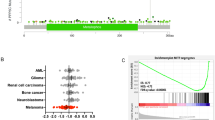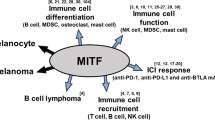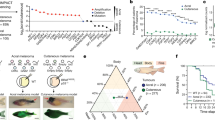Abstract
Germline mutations at loci encoding the transcription factor Microphthalmia (Mi), the cytokine receptor c-Kit, or its ligand Steel factor (Sl) result in strikingly similar defects in mast cell and melanocyte development1,2,3. Here we describe a biochemical link between Kit signalling and the activity of Mi. Stimulation of melanoma cells with Sl results in activation of MAP kinase, which in turn phosphorylates Mi at a consensus target serine. This phosphorylation upregulates Mi transactivation of the tyrosinase pigmentation gene promoter. In addition to modulating pigment production, such signalling may regulate the expression of genes essential for melanocyte survival and development. The pathway represents a new application of the general MAP kinase machinery in transducing a signal between a tissue-specific receptor at the cell surface and a tissue-specific transcription factor in the nucleus.
This is a preview of subscription content, access via your institution
Access options
Subscribe to this journal
Receive 51 print issues and online access
$199.00 per year
only $3.90 per issue
Buy this article
- Purchase on Springer Link
- Instant access to full article PDF
Prices may be subject to local taxes which are calculated during checkout




Similar content being viewed by others
References
Moore, K. J. Insight into the microphthalmia gene. Trends Genet. 11, 442–448 (1995).
Russell, E. Hereditary anemias of the mouse: a review for geneticists. Adv. Genet. 20, 357–459 (1979).
Witte, O. Steel locus defines new multipotent growth factor. Cell 63, 5–6 (1990).
Tassabehji, M., Newton, V. E. & Read, A. P. Waardenburg syndrome type 2 caused by mutations in the human microphthalmia (MITF) gene. Nature Genet. 8, 251–255 (1994).
Hodgkinson, C. A. et al. Mutations at the mouse microphthalmia locus are associated with defects in a gene encoding a novel basic-helix-loop-helix-zipper protein. Cell 74, 395–404 (1993).
Steingrimsson, E. et al. Molecular basis of mouse microphthalmia (mi) mutations helps explain their developmental and phenotypic consequences. Nature Genet. 8, 256–263 (1994).
Hemesath, T. J. et al. microphthalmia, a critical factor in melanocyte development, defines a discrete transcription factor family. Genes Dev. 8, 2770–2780 (1994).
Isozaki, K. et al. Cell type-specific deficiency of c-kit gene expression in mutant mice of mi/mi genotype. Am. J. Path. 145, 827–836 (1994).
Dubreuil, P. et al. The c-fms gene complements the mitogenic defect in mast cells derived from mutant W mice but not mi (microphthalmia) mice. Proc. Natl Acad. Sci. USA 88, 2341–2345 (1991).
Okuda, K. et al. Granulocyte-macrophage colony-stimulating factor, interleukin-3, and steel factor induce rapid tyrosine phosphorylation of p42 and p44 MAP kinase. Blood 79, 2880–2887 (1992).
Marshall, C. Specificity of receptor tyrosine kinase signaling: transient versus sustained extracellular signal-regulated kinase activation. Cell 80, 179–185 (1995).
Treisman, R. Regulation of transcription by MAP kinase cascades. Curr. Opin. Cell Biol. 8, 205–215 (1996).
Ahn, N., Seger, R. & Krebs, E. The mitogen-activated protein kinase activator. Curr. Opin. Cell Biol. 4, 992–999 (1992).
Boyle, W., van der Geer, P. & Hunter, T. Phosphopeptide mapping and phosphoamino acid analysis by two-dimensional separation on thin-layer cellulose plates. Methods Enzymol. 210, 110–149 (1991).
Hearing, V. & Jiminiez, M. Mammalian tyrosinase — the critical regulatory control point in melanocyte pigmentation. J. Biochem. 19, 1141–1147 (1987).
Bentley, N. J., Eisen, T. & Goding, C. R. Melanocyte-specific expression of the human tyrosinase promoter: activation by the microphthalmia gene product and role of the initiator. Mol. Cell. Biol. 14, 7996–8006 (1994).
Yasumoto, K., Yokoyama, K., Shibata, K., Tomita, Y. & Shibahara, S. Microphthalmia-associated transcription factor as a regulator for melanocyte-specific transcription of the human tyrosinase gene[erratum, Mol. Cell. Biol. 15, 1833 (1995))]. Mol. Cell. Biol. 14, 8058–8070 (1994).
Costa, J. et al. Recombinant human stem cell factor (kit ligand) promotes human mast cell and melanocyte hyperplasia and functional activation in vivo. J. Exp. Med. 183, 2681–2686 (1996).
Englaro, W. et al. Mitogen-activated protein kinase pathway and AP-1 are activated during cAMP-induced melanogenesis in B-16 melanoma cells. J. Biol. Chem. 270, 24315–24320 (1995).
Bertolotto, C., Bille, K., Ortonne, J. & Ballotti, R. Regulation of tyrosinase gene expression by cAMP in B16 melanoma cells involves two CATGTG motifs surrounding the TATA box: implication of the microphthalmia gene product. J. Cell Biol. 134, 747–755 (1996).
Ebi, Y. et al. Low c-kit expression of cultured mast cells of mi/mi genotype may be invovled in their defective responses to fibroblasts that express the ligand for c-kit. Blood 80, 1454–1462 (1992).
Tsujimura, T. et al. Involvement of transcription factor encoded by the mi locus in the expression of c-kit receptor tyrosine kinase in cultured mast cells of mice. Blood 88, 1225–1233 (1996).
Paulson, R., Vesey, S., Siminovitch, K. & Berstein, A. Signalling by the W/Kit receptor tyrosine kinase is negatively regulated by the protein tyrosine phosphatase Shp1. Nature Genet. 13, 309–315 (1996).
Lorenz, U. et al. Genetic analysis reveals cell type-specific regulation of receptor tyrosine kinase c-Kit by the protein tyrosine phosphatase SHP1. J. Exp. Med. 184, 1111–1126 (1997).
Tachibana, M. et al. Cloning of MITF, the human homolog of the mouse microphthalmia gene and assignment to chromosome 3p14.1–p12.3. Hum. Mol. Genet. 3, 553–557 (1994).
Mizushima, S. & Nagata, S. pEF-BOS, a powerful mammalian expression vector. Nucleic Acids Res. 18, 5322 (1990).
Stanton, V., Nichols, D., Laudano, A. & Cooper, G. Definition of the human raf amino-terminal regulatory region by deletion mutagenesis. Mol. Cell. Biol. 9, 639–647 (1989).
Acknowledgements
We thank J. Jackson and J. Abraham for technical help, S. Galli, G. Cooper, M.Greenberg, B. Neel, D. Ron and P. Sharp for discussion, R. Halaban for 501mel cells, and members of the Burakoff laboratory for advice and assistance. This work was supported by grants from the NIH, the Pew Foundation, and the James S. McDonnell Foundation. T.J.H. is a Medical Foundation Fellow; D.E.F. is Nirenberg Fellow.
Author information
Authors and Affiliations
Corresponding author
Rights and permissions
About this article
Cite this article
Hemesath, T., Price, E., Takemoto, C. et al. MAP kinase links the transcription factor Microphthalmia to c-Kit signalling in melanocytes. Nature 391, 298–301 (1998). https://doi.org/10.1038/34681
Received:
Accepted:
Issue Date:
DOI: https://doi.org/10.1038/34681
This article is cited by
-
Alpha-melanocyte stimulating hormone (α-MSH): biology, clinical relevance and implication in melanoma
Journal of Translational Medicine (2023)
-
Salvage of ribose from uridine or RNA supports glycolysis in nutrient-limited conditions
Nature Metabolism (2023)
-
Acetylation reprograms MITF target selectivity and residence time
Nature Communications (2023)
-
PPP6C, a serine-threonine phosphatase, regulates melanocyte differentiation and contributes to melanoma tumorigenesis through modulation of MITF activity
Scientific Reports (2022)
-
ERK signalling: a master regulator of cell behaviour, life and fate
Nature Reviews Molecular Cell Biology (2020)
Comments
By submitting a comment you agree to abide by our Terms and Community Guidelines. If you find something abusive or that does not comply with our terms or guidelines please flag it as inappropriate.



